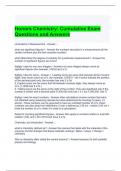Chemistry cumulative - Study guides, Class notes & Summaries
Looking for the best study guides, study notes and summaries about Chemistry cumulative? On this page you'll find 318 study documents about Chemistry cumulative.
All 318 results
Sort by
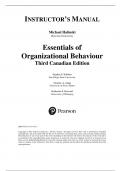 Popular
Popular
-
Instructor Manual For Essentials of Organizational Behaviour Third Canadian Edition
- Exam (elaborations) • 215 pages • 2024
-
- $42.69
- 1x sold
- + learn more
INSTRUCTOR’S MANUAL Michael Halinski Ryerson University Essentials of Organizational Behaviour Third Canadian Edition Stephen P. Robbins San Diego State University Timothy A. Judge University of Notre Dame Katherine E. Breward University of Winnipeg ISBN 978-0-13-731781-3 Copyright © 2023 Pearson Canada Inc., Toronto, Ontario. All rights reserved. This work is protected by Canadian copyright laws and is provided solely for the use of instructors in teaching their courses and a...
 Popular
Popular
-
Test Bank Focus on Nursing Pharmacology 8th Edition Karch
- Exam (elaborations) • 972 pages • 2024 Popular
-
Available in package deal
-
- $15.49
- 1x sold
- + learn more
Test Bank Focus on Nursing Pharmacology 8th Edition KarchCONTENTS Chapter 01 - Introduction to Drugs .................................................................................................... 2 Chapter 02 - Drugs and the Body .................................................................................................... 19 Chapter 03 - Toxic Effects of Drugs ................................................................................................. 35 Chapter 04 - The Nursi...

-
Chemistry Cumulative Exam Bundle
- Package deal • 34 items • 2024
-
- $40.49
- + learn more
1 Exam (elaborations) MP3 Chem Cumulative Test Review 2024 Questions and Answers 2 Exam (elaborations) IB Chemistry Cumulative Final Exam Questions and Answers 3 Exam (elaborations) Honors Chemistry Semester 1 Cumulative Test 100% solved 4 Exam (elaborations) Honors Chemistry Cumulative Exam Questions and Answers (Graded A) 5 Exam (elaborations

-
Chemistry Cumulative Questions and Answers Graded A+
- Exam (elaborations) • 23 pages • 2024
-
Available in package deal
-
- $9.99
- + learn more
Chemistry Cumulative Questions and Answers Graded A+ Which sphere of the Earth system includes the cryosphere? Biosphere Lithosphere Atmosphere Hydrosphere Hydrosphere For which task is using moles most relevant? Calculating the density of a substance. Measuring the temperature change during a reaction. Determining the number of atoms in a container of liquid. Analyzing the color change in a solution. 2 Determining the number of atoms in a container of liquid. In t...
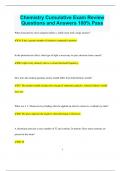
-
Chemistry Cumulative Exam Review Questions and Answers 100% Pass
- Exam (elaborations) • 40 pages • 2024
-
Available in package deal
-
- $11.49
- + learn more
Chemistry Cumulative Exam Review Questions and Answers 100% Pass What characteristic most uniquely defines a stable atom with a large nucleus? A) It has a greater number of neutrons compared to protons. In the photoelectric effect, what type of light is necessary to eject electrons from a metal? B) Light of any intensity above a certain threshold frequency. How does the modern quantum atomic model differ from John Dalton's model? C) The modern model includes the concept of subatomi...
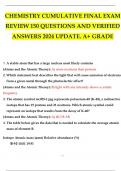
-
CHEMISTRY CUMULATIVE FINAL EXAM REVIEW 150 QUESTIONS AND VERIFIED ANSWERS 2024
- Exam (elaborations) • 27 pages • 2024
-
- $17.99
- + learn more
CHEMISTRY CUMULATIVE FINAL EXAM REVIEW 150 QUESTIONS AND VERIFIED ANSWERS 2024 CHEMISTRY CUMULATIVE FINAL EXAM REVIEW 150 QUESTIONS AND VERIFIED ANSWERS 2024 CHEMISTRY CUMULATIVE FINAL EXAM REVIEW 150 QUESTIONS AND VERIFIED ANSWERS 2024
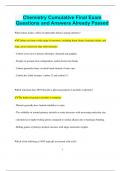
-
Chemistry Cumulative Final Exam Questions and Answers Already Passed
- Exam (elaborations) • 37 pages • 2024
-
Available in package deal
-
- $10.99
- + learn more
Chemistry Cumulative Final Exam Questions and Answers Already Passed What feature makes carbon exceptionally distinct among elements? Carbon can form a wide range of structures, including linear chains, branched chains, and rings, more extensively than other elements. - Carbon exists in two distinct allotropes: diamond and graphite. - Despite its ground state configuration, carbon forms four bonds. - Carbon generally forms covalent bonds instead of ionic ones. - Carbon has stable isoto...
Honors Chemistry Cumulative Exam Questions and Answers
Chemistry Cumulative Exam Review
Chemistry Cumulative Final Exam
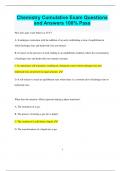
-
Chemistry Cumulative Exam Questions and Answers 100% Pass
- Exam (elaborations) • 18 pages • 2024
-
Available in package deal
-
- $9.99
- + learn more
Chemistry Cumulative Exam Questions and Answers 100% Pass How does pure water behave at 25°C? A. It undergoes ionization with the addition of an acid, establishing a state of equilibrium in which hydrogen ions and hydroxide ions are formed. B. It ionizes in the presence of acid, leading to an equilibrium condition where the concentration of hydrogen ions and hydroxide ions remains constant. C. It experiences self-ionization, resulting in a balanced system where hydrogen ions and hyd...
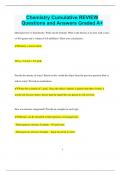
-
Chemistry Cumulative REVIEW Questions and Answers Graded A+
- Exam (elaborations) • 16 pages • 2024
-
Available in package deal
-
- $9.99
- + learn more
Chemistry Cumulative REVIEW Questions and Answers Graded A+ Determine how to find density. Write out the formula. What is the density of an item with a mass of 40.0 grams and a volume of 8.0 milliliters? Show your calculations. Density = mass/volume 40.0 g ÷ 8.0 mL = 5.0 g/mL Provide the density of water? Based on this, would the object from the previous question float or sink in water? Provide an explanation. Water has a density of 1 g/mL. Since the object’s density is greater ...

How much did you already spend on Stuvia? Imagine there are plenty more of you out there paying for study notes, but this time YOU are the seller. Ka-ching! Discover all about earning on Stuvia



